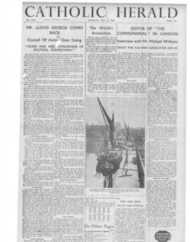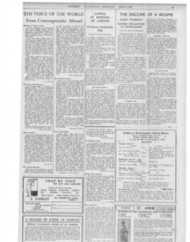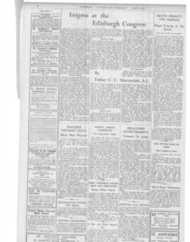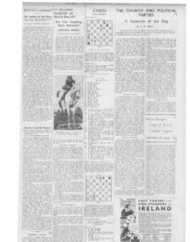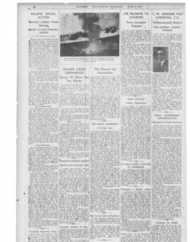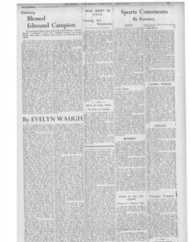Page 16, 6th July 1935
Page 16

Report an error
Noticed an error on this page?If you've noticed an error in this article please click here to report it.
Tags
Share
Related articles
18,276 Scouts 'not Enough'
Windows Dedicated At Launceston
Sung Mass In Honour Of Fisher And More
Canterbury Martyr Honoured
Hallett Shrine For Seminary
SS. THOMAS MORE AND JOHN ASH ER Triduuni At Liverpool To Honour New Saints
30,000 AT CATHEDRAL SITE
In honour of SS. Thomas More and John Fisher, the Archdiocese of Lirdrrn-d, at the end of last week, celebrated a it:dman which was conducted at the ProCathedral by Mgr. Downey. Archbishop cf Liverpool. Them were processions On the of the new cathedral, in which thousands took part.
Pontifical high Mass was celebrated or. Friday. Saturday, and Sunday in the ProCathedral, which had been specially decorated in honour of the event, in a red anti while colour scheme--the colours of the martyrs. The sanctuary was particularly striking, with two special banners deeicting SS. Thomas More and John Fisher, the work of a prominent artist, and mountc.c. on a special background designed by the nuns of Druids Cross Orphanage, Liverpool. Their effectiveness was further : centuated by their being cleverly fleod-Iii Below them was a display of palms and In axe, typifying martyrdom.
On the opening day the celebrant of the Mass was the Archbishop of Liverpool who wore a magnificent fifteenthventury vestment which has iccently been presented to the Liverpool Metropolitan Cathedral, On Saturday, Mgr. Dobson, Y.G., pontificated, and on the concluding slay, Mgr. Downey again. An impressive feature of the celebrations was the children's service on Friday evening, at the Cathedral site, when over
12,000 children were present. 1200 o these boys and girls took part in a grea: procession around the site, the girls being mostly attired in white and each bearing a bunch of red and white llewera. The procession was preceded by a monster banner showing the saints being borne t heaven by angels from Tyburn the ecen: of their martyrdom. Assisting the Archbishop were Frs. H. Dawber and J. Geary (deacons), and UrS. J. Kelly. W. Grace, and J. Wareing. The singing we'. led by the Liverpool Teaehers' Choir under the direction of Dom Willson, (0.S.B.
Spechttly for Children In an address to the children the Arch bishop said St. Thomas More and St. John Fisher were men of gi eat position, friend:7, of the king and at one time his 'counsellors and advisors. But a time. came when the king, Henry VIII, for his own purposes, sought to have himself pro-claimed by parliament supreme head of the Church in this country, with full power to rule it as the Pope had done before. St. John Fisher, who was then Bishop of Ruchester, insisted that the head ef the Church of Christ in England must be the same as the head of the Church anywhere else. He stated in plain terms the scriptural doctrine of the Pope's spiritual supremacy, and pointed in witness o at to the constant belief and practice ol The ages front the time of St. Peter.
In vain, he went on, did St. John Fisher 'remonstrate with the king that if he Henry VIII, could make himself the head of the Church in this country, every other king in Christendom could do the same in The country which he ruled, and there would be as many different churches of Christ as there were kings, whereas the
ideal of our Blessed Lord was that there should be one fold and one shepherd. St, Thomas More, who was chancellor of the realm of England, joined his protest that of the bishop and, whilst denying that the king had any right to rule the Church -of Christ, professed full loyalty to him io :sovereign in ell temporal affairs. For their loyalty to the Pope they were beheaded a the Tower or London just 400 years ag Recently. he continued, their names have been added to the Kalendar of saints who
.are honoured throughout the Catholic Church. They were outstanding English:men ill their day, men who loved their country and eerved it, and loyal to the _king in all things that did not run counter .to their higher loyalty.
30,000 at Cathedral Site Assisting the Archbishop at the high Mass on Sunday were Frs. G. Doyle (deacon), J. Barrow (sub-deacon). Mgr. Redmond (assistant priest), J. Geary, and K. Durand (deacons at the throne), and Mgr. Adamson and Fr. L. Curry, M.C.s.
The public demonstration in the after.noon was one of the greatest seen on Merseyside since the foundation-stone of the Metropolitan Cathedral was laid. Over 30,000 people were present, for many of whom there was no space on the great Cathedral site. They thronged the open space formed by the junction of Mount Pleasant and Hope Street. Rain fell heavily during the morning but cleared a short time before the service was due to commence. The men and women assembled at St. George's Hall and Queen's Square in the centre of the city and marched to the site. The former were led by the silver band of the 87th Boy Scout troop.
The liturgical procession commenced from Maryland Street Demonstration _school. led by the great banner of the saints. and was made up of contingents of school girls, the boys of Bishop's Court school, the Guild of St. Agnes. the Chiltdren of Mary, Girl Guides, flag bearers of the Various Scout troops, students of Mount Pleasant training college. the Knights of St. Columba, the Catemans. the Young Men's Society, one hundred altar f,ervers, the Mayor of Wigan (Councillor a O'Rourke), the Mayor of Warrington 1Councillor A. Crowe), the Mayor of St
Helens (Councillor J. O'Brien), and the ....... lit the uniform of a Knight of Malta, and Mr. James Faulkner, J.P., arid about one hundred regular and secular clergy. The Archbishop was attens1ed by members of the Metropolitan chapter and dignitaries of the archdiocese.
The procession entered the site by the eastern entrance and after traversing the main passage aisles halted at a special altar on the south side where benediction was given.
In the course of his sermon Mgr. Downey. on Sunday, gave a fuller account of the lives of the martyrs than he had given to the children earlier in the triduum.
Speaking on the life of St. John Fisher he pointed out that if fell into three distinct parts.
Three Stages The first consisted of the years up to 1504 or 1505 A.D. It was the academic period during which he laid the foundation of his solid scholarship, and advanced step by step to the highest honours in his uniscrsity.
In the second period, from 1505 to 1525 A.D., he was a bishop, primarily devoted to his pastoral charge, practising in the greater privacy which the old episcopal palace at Rochester gave him, that player, self-denial and mortification which were to make him a saint before he was z martyr.
The third period, from 1525 to 1535, A.D. was one of storm and stress, beginning with the question of Henry divorce, developing into the submission of the clergy and the schism of the royal supremacy, and ending with his death on the scaffold.
For thirty years, whilst Bishop of Rochester, he gave an edifying example of humility and detachment, refusing to see in the offer of a wealthier diocese a reason for its acceptance merely because it provided more comfort. While at Rochester he dealt with attacks upon the religion of which he was so intelligent a champion.
Henry VIII is said to have considered Fisher to be the most learned theologian in Europe. One could well understand, then, the rage of the king at the bishop's clear and uncompromising judgment on the question of his divorce.
Henry had married Catherine of Aragon in 1509. Catherine, from all accounts, was a charming, good-tempered, devout Spanish lady. About 1527 he became the slave of Anne Boleyn. He was so blinded by passion that he thought first to get a licence to live bigamously with her. WoIsey apparently persuaded Henry of the futility of such a proceeding, and advised him to try instead to find some flaw in the marriage with Catherine. Fisher, as a prominent scholar and theologian, was asked his opinion.
His reply provides the second of the two fundamental principles which determined his actions between 1525 and 1535. He had written in opposition to Luther that the Pope was the supreme head of the whole Christian Church. He now laid down just as clearly his belief that the marriage with Queen Catherine was valid. Rome gave the same decision in 1534, and Gairdner, a non-Catholic authority, says: "the tribunal at Rome was a per fectly just one—at least in this ingi?.er there could he no doubt of its justice."
More Stands Firm The fall of Wolecy brought in Thomas Cromwell as the King's chief minister, and Thomas More as chancellor. Cromwell was not the type whose service was constrained by religious principles. More was entirely different. A scholar, like Fisher, he had been in the fore-front of the revival of letters. A man cn: great learning, of keen wit and of distinctive personal charm, he was one whose company delighted the king. Yet he had told Henry on taking office that he could not help him in the matter of the divorce. It was an ominous beginning.
More became chancellor in 1529. He resigned in 1532, as a result of Henry's enforcing the submission of the clergy, which required them to admit Henry's claim to be protector and supreme head of the English Church and clergy. Fisher opposed the tide strenuously. It is not surprising that he who had argued at such length and so powerfully for the supremacy of St. Peter's successor, should speak with equal force before convocation. Convocation bowed to Henry's demands, but More. who admitted the influence of the Bishop of Rochester on his views, found that he could not in conscience administer the law under such a master.
Instrument of Death In 1534 parliament passed the act of Succession, for in September of the previous year, Princess Elizabeth had been born. This act was the instrument by which Fisher and More were brought to their deaths. Both were willing enough to take the oath so far as the mere succession was concerned; both acknowledged that parliament was acting within its competence in dealing with the succession; but the commissioners added to the oath a (Continc from previous column.) where he would be chargeable, and he was unwilling to expose himself rashly to the impeachment.
Both Fisher and More were sent to the Tower and the precise legal ground for their condemnation is difficult to determine.
The triduum concluded with the Archbishop's pronunciation of the apostolic blessing by special commission of the Pope, delivered to him .n D nen,. tar6....
blog comments powered by Disqus


